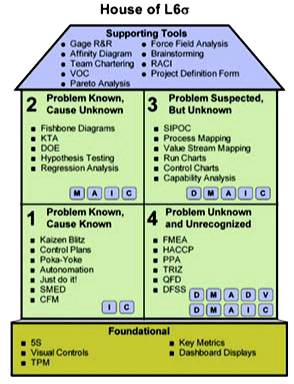

Six-Sigma is already benefiting organizations operating in many and different sectors across the globe in terms of increasing market share, customer satisfaction, cost reduction and dramatic boost to bottom-line of the company. This methodology is proven in all sectors of industry with above average degree of success.
Six Sigma by and large finds application in large organizations (say 500+ employees company). An important factor in the spread of Six Sigma was GE’s 1998 announcement of $350 million in savings thanks to Six Sigma, a figure that later grew to more than $1 billion. As per renowned industry consultants like John Kullmann andThomas Pyzdek, companies with less than 500 employees are less suited to Six-Sigma implementation or need to adapt the standard approach to make it work for them. Six-Sigma however carries a large number of tools and techniques that work well in small to mid-size organizations. The fact that an organization is not big enough to be able to afford Black Belts does not belittle its abilities to make improvements using this set of tools and techniques. The infrastructure required as necessary to support Six Sigma is a result of the size of the organization rather than a requirement of Six Sigma itself.
Whilst the scope of Six Sigma disagrees depending on where it is implemented, it can successfully deliver its benefits to different applications.

After its first application at Motorola in the late 1980s, other internationally recognized companies currently recorded high number of savings after applying Six Sigma. Examples of these are Honeywell, Johnson and Johnson, with $600 million of reported savings, Texas Instruments, which saved over $500 million as well as Telefónica de Espana, which reported €30 million in savings in the initial 10 months of the project. Besides this, various organizations like Sony and Boeing achieved large percentages in waste reduction after the successful collaboration of Lean with six sigma.

Whilst companies have considered common quality control and process improvement strategies, there’s still a need for more reasonable and effective methods as all the desired standards and client satisfaction have not always been reached. There is even a demand for unnecessary analysis that can control the factors affecting concrete cracks and slippage between concrete and steel. Subsequently carrying on a case study on Tinjin Xianyi Construction Technology Co, Ltd., it was realised that construction time and construction waste were reduced by 26.2% and 67% consequently after adopting Six Sigma. Similarly, Six Sigma implementation was studied at one of the largest engineering and construction companies in the world: Bechtel Corporation, where after an initial investment of $30 million in a Six Sigma program that included identifying and preventing rework and defects, over $200 million were saved.

Six Sigma has brought an important role by amending accuracy of allocation of cash to reduce bank charges, automatic payments, improving accuracy of reporting, reducing documentary credits defects, reducing check collection defects, and reducing variation in collector performance. Financial institutions that have reported considerable betterment in their operations are Bank of America and American Express. By 2004 Bank of America increased customer satisfaction by 10.4% and decreased customer issues by 24% by applying Six Sigma tools in their contour operations. Similarly, AmeEx successfully eliminated non-received renewal credit cards and improved their overall processes by applying Six Sigma methodologies and principles. This approach is also currently being applied by other financial institutions like GE Capital Corp., JP Morgan Chase, and SunTrust Bank, with customer satisfaction comprising their main objective.

This is alsocrucial to ensure that products are deported to clients at the right time while maintaining high-quality standards from the beginning to the end of the supply chain. By changing the schematic diagram for the supply chain, Six Sigma can ensure quality control on products and ensure delivery deadlines, which are the major issues involved in the supply chain.

The status of Six Sigma application and implementation in the software industry identifies the commonly used statistical and non statistical and software engineering tools and a framework used within software business; and determines the important success factors (CSFs) for a successful Six letter of the alphabet initiative within the software/IT trade. The most necessary issue was management commitment and involvement. Documentation management and suppliers’ involvement were found to be the smallest amount necessary factors.

Healthcare is a sphere that has been highly coped with this school of thoughts for many years because of the nature of zero tolerance for mistakes and potential for reducing medical errors involved in healthcare. The goal of Six Sigma in healthcare is extensive and includes reducing the inventory of medicines and equipment that brings extra costs, altering the process of healthcare delivery in order to make more efficient and refining reimbursements. The approach proved helpful in terms of utilizing Beds by increasing patient turnover, reduced inventory of medicines, improving patient care process, increased patient satisfaction. The analyse at the University of Texas MD Anderson Cancer Center, which recorded an increment in examinations with no additional machines of 45% and reduction in patients’ preparation time of more than 40 minutes to less than 5 minutes in multiple cases.
